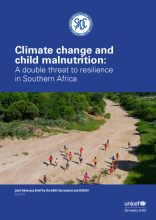Climate change and child malnutrition are two of the greatest threats facing the Southern African Development Community (SADC) today. They converge geographically, share common systemic and societal drivers, and both threaten the future economic growth, prosperity and resilience of nations.
The 2018 SADC Regional Vulnerability Assessment and Analysis Synthesis Report1 indicates that the impacts of climate change are escalating food insecurity, weakening social capital and leading to widespread vulnerabilities in the SADC region. As a result, millions of families are struggling to meet their children’s nutritional needs, leading to multiple forms of malnutrition that hinder children’s healthy growth, development, future prosperity and resilience. It is estimated globally that, by 2050, climate change will cause an additional 28 million children to be wasted (acutely malnourished) and 40 million children to be stunted (chronically malnourished).
The SADC Climate Change Strategy and Action Plan (2020-2030) provides a broad outline for harmonized and coordinated actions by SADC Member States to address and respond to the impacts of climate change and plan for a low-carbon resilient future.3 Building on this strategy, innovative, context-specific actions are needed to safeguard child nutrition in the context of a changing climate. This brief aims to inform policy- and decision-makers of the links between climate change and child nutrition, and key policy and programmes actions that can be built into policies, plans and investment cases, with an emphasis on climate adaptation. Actions are intended to be led by SADC Member States, with potential for the involvement of multiple stakeholders and regional coordination given the shared nutrition, environmental, economic and political landscape.

